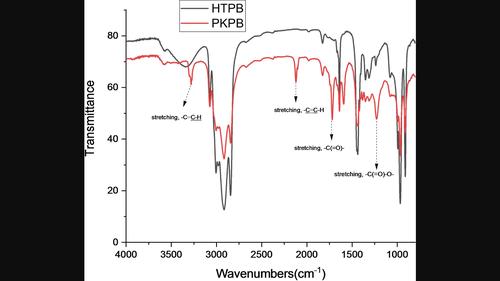当前位置:
X-MOL 学术
›
Propellants Explos. Pyrotech.
›
论文详情
Our official English website, www.x-mol.net, welcomes your
feedback! (Note: you will need to create a separate account there.)
Propiolate-Terminated Polybutadiene-Based Network Binders for Solid Propellants via Catalyst-Free Azide-Alkyne Cycloaddition
Propellants, Explosives, Pyrotechnics ( IF 1.7 ) Pub Date : 2022-08-05 , DOI: 10.1002/prep.202200162 ByoungSun Min 1 , Jinhyuk Lee 1 , Sung June Kim 1 , Hong-Min Shim 1
Propellants, Explosives, Pyrotechnics ( IF 1.7 ) Pub Date : 2022-08-05 , DOI: 10.1002/prep.202200162 ByoungSun Min 1 , Jinhyuk Lee 1 , Sung June Kim 1 , Hong-Min Shim 1
Affiliation

|
We developed the new preparation method of polybutadiene-based binders, which has been widely used in solid composite propellants, under the triazole curing system formed by the Huisgen azide-alkyne cycloaddition (AAC) without any promotors. Firstly, polybutadiene terminated with propiolate, alkyne adjacent to electron-withdrawing group −C(=O)O−, PKPB(propiolate-terminated polybutadiene), was prepared followed by the 1,3-cycloaddition with trivalent azide curatives leading to form the polybutadiene binder cured via triazole linkages. Unexpectedly, compared to the conventional urethane-cured binders, higher temperature and long time were required to cure the polybutadiene binder and the mechanical properties, especially tensile strength was not as good as that of binder formed under urethane curing system. For the triazole-cured polybutadiene binder to exhibit the better mechanical properties, an asymmetric difunctional chain-linker end-capped with an alkyne and an isocyanate, respectively was introduced to modify the end-groups of hydroxyl-terminated polybutadiene (HTPB) with propiolates, ester alkynes, resulting in forming the propiolate-terminated polyurethane butadiene (PTPUB). The triazole-cured polyurethane butadiene-based binders obtained from the click reaction of PTPUB with tri-azide curatives conveyed the excellent mechanical properties as well as considerable shortening of reaction time, compared to PKPB-based binders. Finally, both of triazole cured binders showed the good low-temperature properties, Tg, available for solid propellants.
中文翻译:

通过无催化剂叠氮化物-炔烃环加成用于固体推进剂的丙酸封端聚丁二烯基网络粘合剂
我们开发了聚丁二烯基粘合剂的新制备方法,该方法已广泛用于固体复合推进剂,在没有任何促进剂的Huisgen叠氮化物-炔烃环加成(AAC)形成的三唑固化体系下。首先,制备用丙炔酸酯封端的聚丁二烯、与吸电子基团-C(=O)O-相邻的炔烃、PKPB(丙炔酸酯封端的聚丁二烯),然后与三价叠氮化物固化剂进行1,3-环加成反应,形成聚丁二烯通过三唑键固化的粘合剂。出乎意料的是,与传统的聚氨酯固化粘合剂相比,聚丁二烯粘合剂需要更高的温度和更长的时间来固化,其力学性能,尤其是拉伸强度不如聚氨酯固化体系下形成的粘合剂。为了使三唑固化的聚丁二烯粘合剂表现出更好的机械性能,引入了分别用炔烃和异氰酸酯封端的不对称双官能链连接剂,以用丙炔酸酯修饰端羟基聚丁二烯(HTPB)的端基,酯炔烃,导致形成丙炔酸酯封端的聚氨酯丁二烯 (PTPUB)。与 PKPB 基粘合剂相比,由 PTPUB 与三叠氮化物固化剂的点击反应获得的三唑固化聚氨酯丁二烯基粘合剂具有优异的机械性能和显着缩短的反应时间。最后,两种三唑固化粘合剂均表现出良好的低温性能,T 分别被引入以用丙炔酸酯、酯炔烃修饰端羟基聚丁二烯(HTPB)的端基,从而形成端丙炔酸酯聚氨酯丁二烯(PTPUB)。与 PKPB 基粘合剂相比,由 PTPUB 与三叠氮化物固化剂的点击反应获得的三唑固化聚氨酯丁二烯基粘合剂具有优异的机械性能和显着缩短的反应时间。最后,两种三唑固化粘合剂均表现出良好的低温性能,T 分别被引入以用丙炔酸酯、酯炔烃修饰端羟基聚丁二烯(HTPB)的端基,从而形成端丙炔酸酯聚氨酯丁二烯(PTPUB)。与 PKPB 基粘合剂相比,由 PTPUB 与三叠氮化物固化剂的点击反应获得的三唑固化聚氨酯丁二烯基粘合剂具有优异的机械性能和显着缩短的反应时间。最后,两种三唑固化粘合剂均表现出良好的低温性能,T 与 PKPB 基粘合剂相比,由 PTPUB 与三叠氮化物固化剂的点击反应获得的三唑固化聚氨酯丁二烯基粘合剂具有优异的机械性能和显着缩短的反应时间。最后,两种三唑固化粘合剂均表现出良好的低温性能,T 与 PKPB 基粘合剂相比,由 PTPUB 与三叠氮化物固化剂的点击反应获得的三唑固化聚氨酯丁二烯基粘合剂具有优异的机械性能和显着缩短的反应时间。最后,两种三唑固化粘合剂均表现出良好的低温性能,Tg,可用于固体推进剂。
更新日期:2022-08-05
中文翻译:

通过无催化剂叠氮化物-炔烃环加成用于固体推进剂的丙酸封端聚丁二烯基网络粘合剂
我们开发了聚丁二烯基粘合剂的新制备方法,该方法已广泛用于固体复合推进剂,在没有任何促进剂的Huisgen叠氮化物-炔烃环加成(AAC)形成的三唑固化体系下。首先,制备用丙炔酸酯封端的聚丁二烯、与吸电子基团-C(=O)O-相邻的炔烃、PKPB(丙炔酸酯封端的聚丁二烯),然后与三价叠氮化物固化剂进行1,3-环加成反应,形成聚丁二烯通过三唑键固化的粘合剂。出乎意料的是,与传统的聚氨酯固化粘合剂相比,聚丁二烯粘合剂需要更高的温度和更长的时间来固化,其力学性能,尤其是拉伸强度不如聚氨酯固化体系下形成的粘合剂。为了使三唑固化的聚丁二烯粘合剂表现出更好的机械性能,引入了分别用炔烃和异氰酸酯封端的不对称双官能链连接剂,以用丙炔酸酯修饰端羟基聚丁二烯(HTPB)的端基,酯炔烃,导致形成丙炔酸酯封端的聚氨酯丁二烯 (PTPUB)。与 PKPB 基粘合剂相比,由 PTPUB 与三叠氮化物固化剂的点击反应获得的三唑固化聚氨酯丁二烯基粘合剂具有优异的机械性能和显着缩短的反应时间。最后,两种三唑固化粘合剂均表现出良好的低温性能,T 分别被引入以用丙炔酸酯、酯炔烃修饰端羟基聚丁二烯(HTPB)的端基,从而形成端丙炔酸酯聚氨酯丁二烯(PTPUB)。与 PKPB 基粘合剂相比,由 PTPUB 与三叠氮化物固化剂的点击反应获得的三唑固化聚氨酯丁二烯基粘合剂具有优异的机械性能和显着缩短的反应时间。最后,两种三唑固化粘合剂均表现出良好的低温性能,T 分别被引入以用丙炔酸酯、酯炔烃修饰端羟基聚丁二烯(HTPB)的端基,从而形成端丙炔酸酯聚氨酯丁二烯(PTPUB)。与 PKPB 基粘合剂相比,由 PTPUB 与三叠氮化物固化剂的点击反应获得的三唑固化聚氨酯丁二烯基粘合剂具有优异的机械性能和显着缩短的反应时间。最后,两种三唑固化粘合剂均表现出良好的低温性能,T 与 PKPB 基粘合剂相比,由 PTPUB 与三叠氮化物固化剂的点击反应获得的三唑固化聚氨酯丁二烯基粘合剂具有优异的机械性能和显着缩短的反应时间。最后,两种三唑固化粘合剂均表现出良好的低温性能,T 与 PKPB 基粘合剂相比,由 PTPUB 与三叠氮化物固化剂的点击反应获得的三唑固化聚氨酯丁二烯基粘合剂具有优异的机械性能和显着缩短的反应时间。最后,两种三唑固化粘合剂均表现出良好的低温性能,Tg,可用于固体推进剂。











































 京公网安备 11010802027423号
京公网安备 11010802027423号